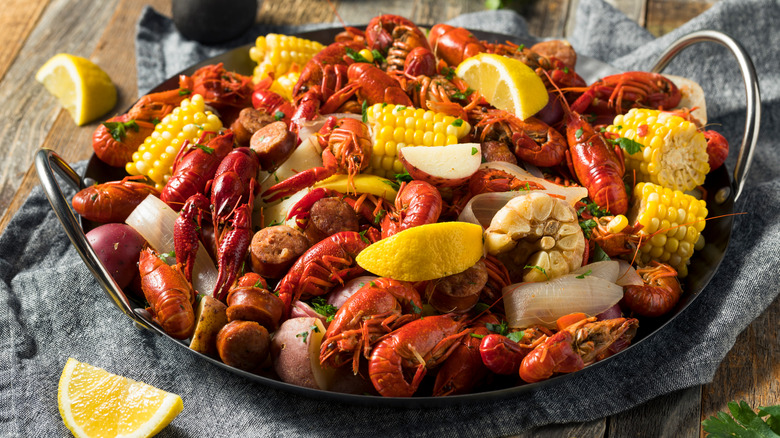Is Eating Crawfish Heads Safe?
Likely you've been there before. Maybe it was a Mardi Gras fête or just a backyard bash. Some enterprising individual has procured a commercial stock pot, a powerful propane burner, and several pounds of the Pelican State's finest mudbugs. Bubbling away is a broth redolent of cayenne, lemon, and garlic. Before you know it, a newspaper covered table is piled with boiled crawfish, half cobs of corn, red skin potatoes, and links of andouille. The feasting begins.
The crawfish — crayfish, crawdads, or crawdaddies, if you please — are a wonderful cross between shrimp and lobster, sweet and tender with an earthiness evocative of backwater bayou terroir. People dig in with their hands, pinching and twisting the meaty tails off and, when they're done scarfing those down, they ... suck on the remaining front half of the carcass. But why would they do that when there's no meat in a crawfish head, and is it even safe to slurp whatever is in there?
What is a crawfish?
Crawfish look a lot like lobsters that have been hit with a shrink ray, and with good cause as they're crustacean cousins, notes the Columbia Journalism Review. They belong to the order Decapoda, owing to the 10 "walking" legs they have extending from the front portion, or cephalothorax, of their body, explains the University of Bristol. Though that body is scientifically divided into 20 distinct segments, the two major divisions are the cephalothorax and the abdomen. The abdomen is home to the pleopods, or "swimming" legs also known as the swimmerets, and is the segment of the crawfish we think of as the "tail" and, more importantly, the part most commonly consumed (via Acadian Crawfish Co.)
While the tail presents most folks with a familiar, albeit smaller, morsel of meat not unlike lobster or shrimp in appearance and flavor, the cephalothorax — more commonly called "the head" — is a bit more complicated. As outlined by Infovisual, the crawfish head accounts for much of the body and contains the internal organs, such as the rudimentary brain, the gut, and the heart. And while those may strike some as unpleasant to eat, note that if you've consumed the tail, you've already eaten a large portion of the crawfish's digestive tract.
To suck or not?
So, the question remains, is it safe to suck the head of a crawfish? The answer is a resounding yes, says Eater Houston, a trusted source as Houston is a city that knows a thing or two about crawfish cookery. The head's various organs, including the liver-like hepatopancreas, provide an assortment of flavors not found in the tail. Further, the cavity, during the boil, fills with the spice-flecked broth, so that when you slurp up the innards, you're met with not just the distinct taste of organs, but a hot and salty shot of juice that's deeply flavored by contact with the crawfish shells.
But are there any instances when crawfish should be avoided? CajunCrawfish.com notes a persistent myth that straight-tailed crawfish, those that leave the boil with their abdomens erect, are best thrown out as this is a hallmark of a crustacean that went into the broth already dead — FYI, crawfish are traditionally boiled alive. A straight tail, however, isn't the best indicator of a bad crawfish. They recommend giving the tail a once over before popping it in your mouth. If the meat is "mushy or crumbly," chuck it and move on. That's the great thing about a crawfish boil: There's more where that came from.


